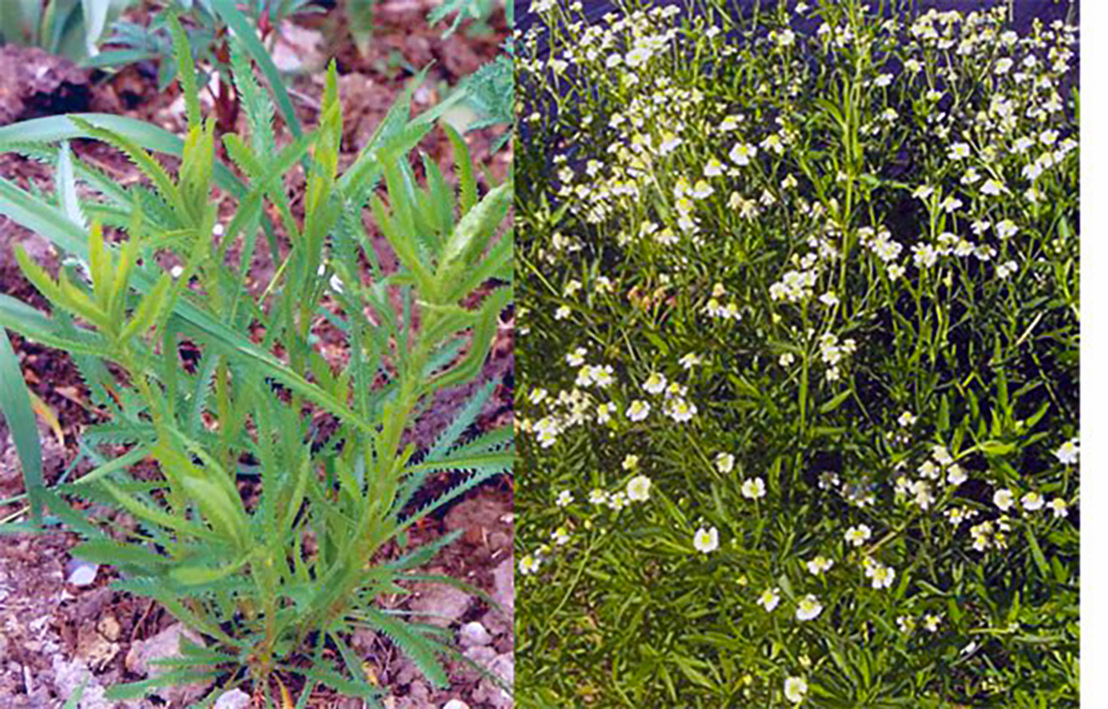 English Mace
Achillea
ageratum young
plant and plant in
flower.
English Mace
Achillea
ageratum young
plant and plant in
flower.
Welcome to the summary page for FabulousFusionFood's Herb guide to English Mace along with all the English Mace containing recipes presented on this site, with 0 recipes in total.
e This is a continuation of an entire series of pages that will, I hope, allow my visitors to better navigate this site. As well as displaying recipes by name, country and region of origin I am now planning a whole series of pages where recipes can be located by meal type and main ingredient. This page gives a listing of all the Cornish recipes added to this site.
These recipes, all contain English Mace as a major herb flavouring.
English Mace, Achillea ageratum (also known as Sweet Maudlin, Sweet Yarrow, or Sweet Nancy) is a flowering perennial culinary herb of the Asteraceae (aster/daisy) family of flowering plants that is native to Central and Southern Europe. Today it is naturalized throughout temperate Europe, but it's original native range is unknown. I have seen reports that indicate Greece or Italy and Spain. Some believe that Achillea ageratum arose as an hybrid between A ptarmica x A macrocephala. English Mace was first introduced into Britain in the 1570s and it was used as a medicinal herb in much the same way as the more well-known Costmary (alecost).
English Mace is an hardy perennial growing to some 30–45cm in height when in flower and some 20cm in diameter. It flowers in summer (between July and September), with the pale cream daisy-like flowers borne on tall and strong flower stems. The flowers are hermaphrodite and are pollinated by bees. The flowers are noted for being long-lived.
The leaves are elongated, some 5cm in length and deeply toothed. Though they can be harvested at any times, the leaves are at their best during spring. They lend themselves to freezing and can also be dried to preserve or to make tea. The laves have a mild, warm, aromatic flavour that combines well with other herbs and goes well with chicken and fish. In terms of sensory quality, The initial flavour is mild and pleasant, though it becomes stronger and aromatic when the leaves are chewed, and leaves a tingly sensation in the mouth. The leaves are best used when young and are suitable for flavouring soups and stews. They can also be chopped and used sparingly in salads and potato salads.
The typical British cultivar of English Mace was discovered in Switzerland in 1798.
e This is a continuation of an entire series of pages that will, I hope, allow my visitors to better navigate this site. As well as displaying recipes by name, country and region of origin I am now planning a whole series of pages where recipes can be located by meal type and main ingredient. This page gives a listing of all the Cornish recipes added to this site.
These recipes, all contain English Mace as a major herb flavouring.
English Mace, Achillea ageratum (also known as Sweet Maudlin, Sweet Yarrow, or Sweet Nancy) is a flowering perennial culinary herb of the Asteraceae (aster/daisy) family of flowering plants that is native to Central and Southern Europe. Today it is naturalized throughout temperate Europe, but it's original native range is unknown. I have seen reports that indicate Greece or Italy and Spain. Some believe that Achillea ageratum arose as an hybrid between A ptarmica x A macrocephala. English Mace was first introduced into Britain in the 1570s and it was used as a medicinal herb in much the same way as the more well-known Costmary (alecost).
English Mace is an hardy perennial growing to some 30–45cm in height when in flower and some 20cm in diameter. It flowers in summer (between July and September), with the pale cream daisy-like flowers borne on tall and strong flower stems. The flowers are hermaphrodite and are pollinated by bees. The flowers are noted for being long-lived.
The leaves are elongated, some 5cm in length and deeply toothed. Though they can be harvested at any times, the leaves are at their best during spring. They lend themselves to freezing and can also be dried to preserve or to make tea. The laves have a mild, warm, aromatic flavour that combines well with other herbs and goes well with chicken and fish. In terms of sensory quality, The initial flavour is mild and pleasant, though it becomes stronger and aromatic when the leaves are chewed, and leaves a tingly sensation in the mouth. The leaves are best used when young and are suitable for flavouring soups and stews. They can also be chopped and used sparingly in salads and potato salads.
The typical British cultivar of English Mace was discovered in Switzerland in 1798.
The alphabetical list of all English Mace recipes on this site follows, (limited to 100 recipes per page). There are 0 recipes in total:
Page 1 of 1
Page 1 of 1